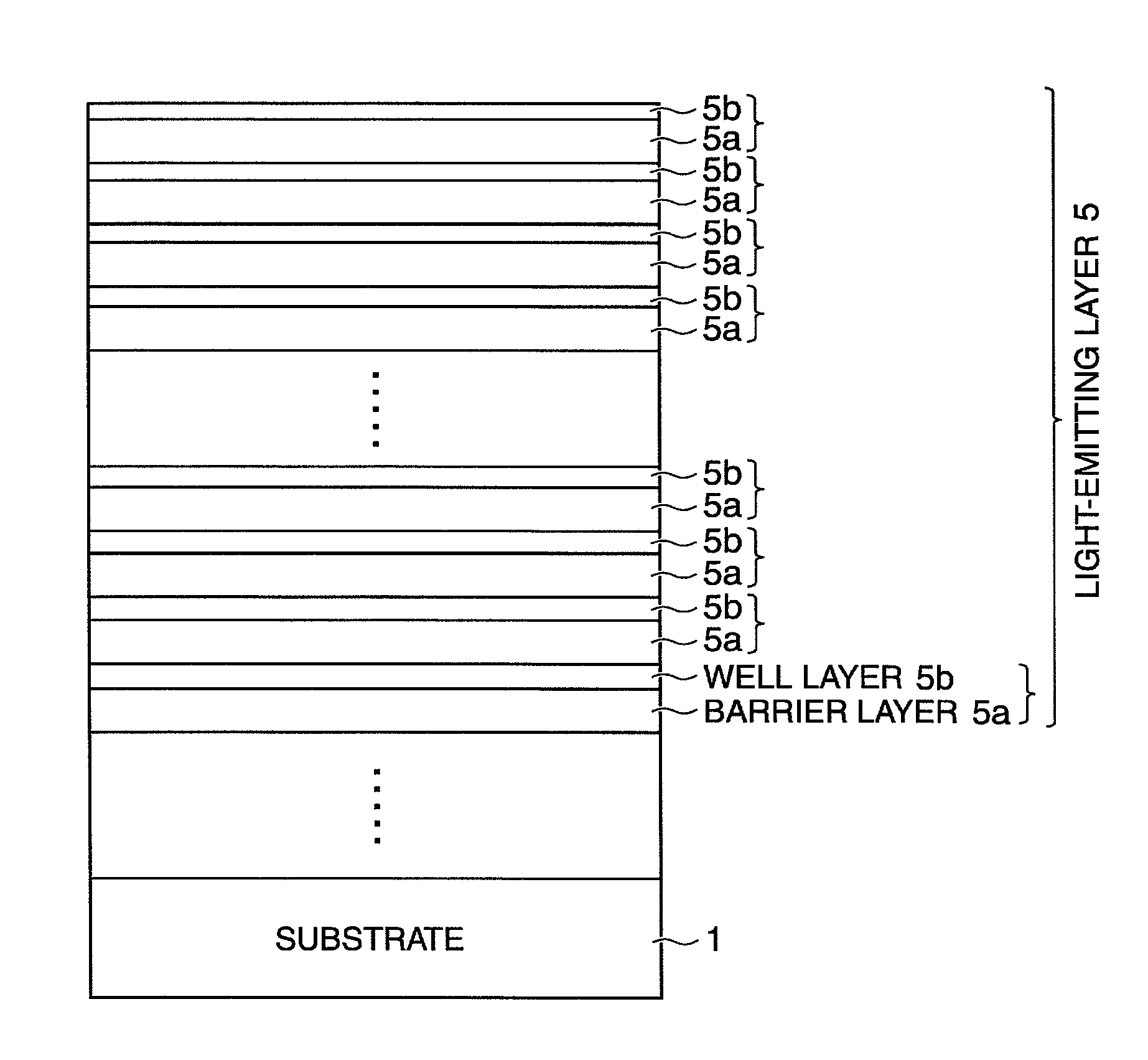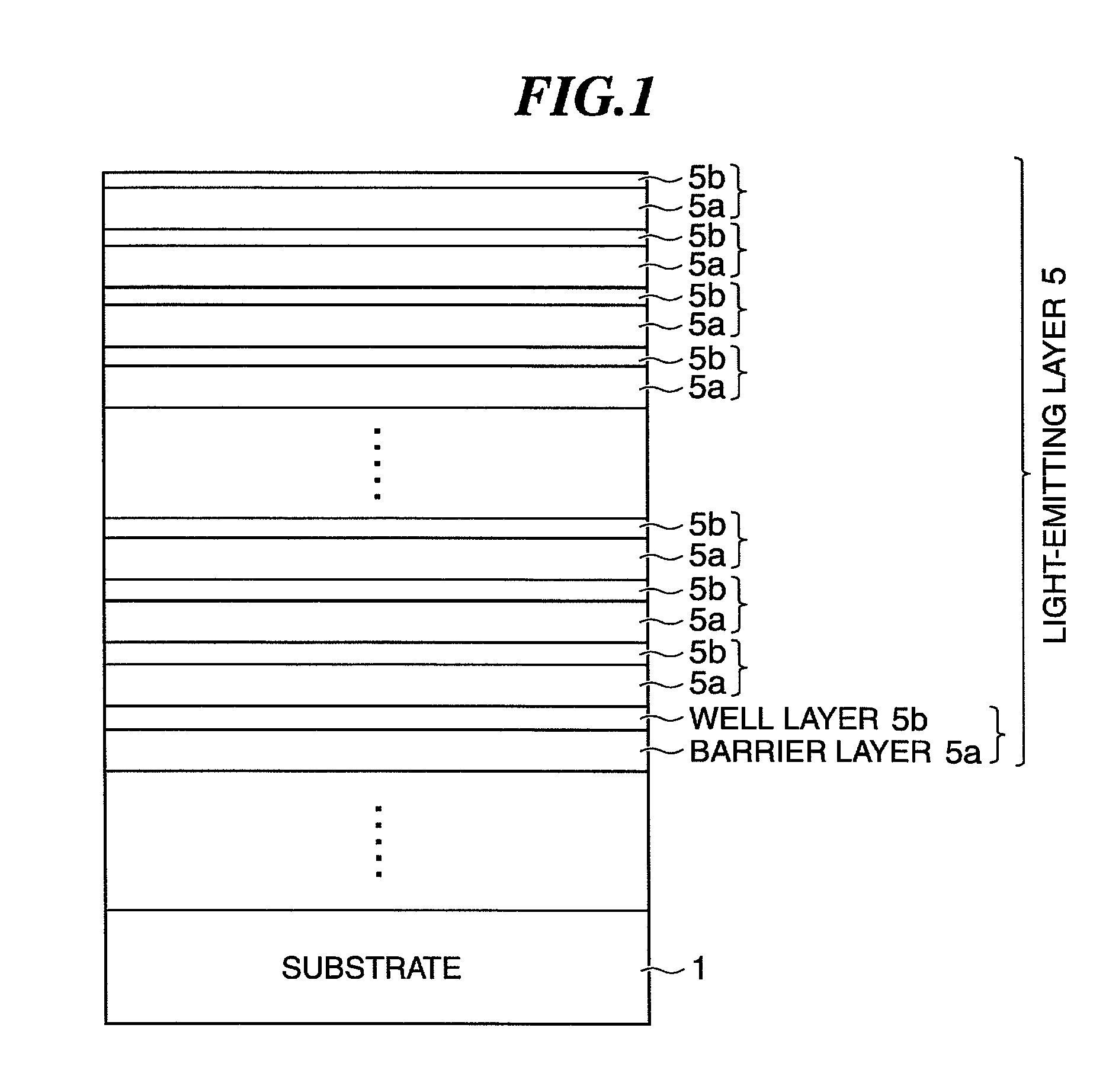Group III nitride semiconductor light-emitting device
a technology of nitride and semiconductor light-emitting devices, which is applied in the direction of semiconductor devices, basic electric elements, electrical equipment, etc., can solve the problems of complex and redundant process for forming rgb-type white leds, inability to achieve light-emitting devices with high luminous intensity, and inability to achieve high luminous intensity. , to achieve the effect of high and stable color rendering properties of white light emission
- Summary
- Abstract
- Description
- Claims
- Application Information
AI Technical Summary
Benefits of technology
Problems solved by technology
Method used
Image
Examples
first embodiment
[0064]FIG. 3 is a schematic cross-sectional view showing a structure of a Group III nitride semiconductor light-emitting device comprising a light-emitting layer having the multiple quantum well structure of a first embodiment. FIG. 4 shows a photoluminescence spectrum radiated from the light-emitting layer having the multiple quantum well structure. In FIG. 4, the horizontal axis represents emission wavelength (unit: Å), and the vertical axis represents emission intensity (unit: arbitrary unit).
[0065]In the formation of a structure for use in production of a Group III nitride semiconductor light-emitting device 10, a {111} silicon single crystal (silicon) was used as a substrate 101.
[0066]The surface of the substrate 101 was cleaned with an inorganic acid, and thereafter the substrate 101 was conveyed into a growth chamber of a molecular beam epitaxy (MBE) growth system. The growth chamber was then evacuated to ultra-high vacuum. Thereafter, the temperature of the substrate 101 was...
second embodiment
[0076]FIG. 5 is a cross-sectional view schematically showing a constitution of a light-emitting layer having the multiple quantum well structure of a Group III nitride semiconductor light-emitting device (LED) of the second embodiment.
[0077]A light-emitting layer 205 having the multiple quantum well structure shown in FIG. 5 was formed, by nitrogen plasma MBE, on a stacked structure comprising the AlN layer, the AlGaN mixed crystal layer, and the n-type GaN layer (204 in FIG. 5) described in the first embodiment and provided on the Si substrate. The light-emitting layer 205 was formed as follows.
[0078]In the formation of the light-emitting layer 205 having the multiple quantum well structure, an n-type GaN barrier layer 205a having a thickness of 16 nm is first provided on the n-type GaN layer 204 by nitrogen plasma MBE. Then, an Mg doped Ga0.80In0.20N well layer as an n-type well layer 205b constituting the multiple quantum well structure was provided so that the n-type well layer ...
third embodiment
[0084]FIG. 7 is a schematic cross-sectional view showing a structure of a Group III nitride semiconductor light-emitting device comprising a light-emitting layer having the multiple quantum well structure of a third embodiment. FIG. 8 is a photoluminescence spectrum in a stacked structure for use in a Group III nitride semiconductor light-emitting device (LED) comprising the light-emitting layer having the multiple quantum well structure of the third embodiment.
[0085]By virtue of nitrogen plasma BME, the light-emitting layer having the multiple quantum well structure was formed on the stacked structure that comprises the AlN layer and the AlGaN mixed crystal layer (303 in FIG. 7) described in the first and second embodiments and provided on an Si substrate. The light-emitting layer is formed as follows.
[0086]In the formation of the light-emitting layer having the multiple quantum well structure, an n-type GaN barrier layer 305a with a thickness of 10 nm was first provided on the AlG...
PUM
 Login to View More
Login to View More Abstract
Description
Claims
Application Information
 Login to View More
Login to View More - R&D
- Intellectual Property
- Life Sciences
- Materials
- Tech Scout
- Unparalleled Data Quality
- Higher Quality Content
- 60% Fewer Hallucinations
Browse by: Latest US Patents, China's latest patents, Technical Efficacy Thesaurus, Application Domain, Technology Topic, Popular Technical Reports.
© 2025 PatSnap. All rights reserved.Legal|Privacy policy|Modern Slavery Act Transparency Statement|Sitemap|About US| Contact US: help@patsnap.com



